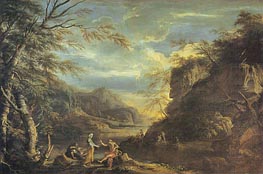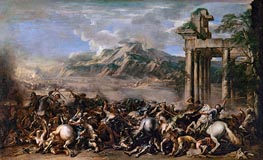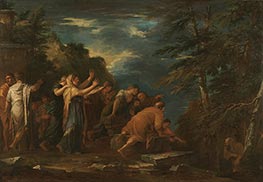
Salvator Rosa Painting Reproductions 1 of 1
1615-1673
Italian Baroque Painter
Salvator Rosa (1615 - March 15, 1673) was an Italian Baroque painter, poet and printmaker, active in Naples, Rome and Florence. As a painter, he is best known as an "unorthodox and extravagant" and a "perpetual rebel" Proto-Romantic. His life and writings were equally colorful.
He was born in Arenella, in the outskirts of Naples: either June 20 or July 21, 1615. His father, Vito Antonio de Rosa, a land surveyor, urged his son to become a lawyer or a priest, and entered him into the convent of the Somaschi fathers. Yet, Salvator showed a preference for the arts, thus secretly worked with his maternal uncle Paolo Greco to learn about painting, and soon transferred himself to his own brother-in-law Francesco Francanzano, a pupil of Ribera, and afterwards to either Aniello Falcone, contemporary with Domenico Gargiulo, or Ribera himself. Some sources claim he spent time living with roving bandits. At the age of seventeen he lost his father; his mother was destitute with at least five children, and Salvator found himself without financial support.
Life
He continued apprenticeship with Falcone, aiding him complete his battlepiece canvases. In that studio, it is said that Lanfranco took notice of his work, and advised him to relocate to Rome, where he stayed for from 1634-6.
Returning to Naples, he began painting haunting landscapes, overgrown with vegetation, or jagged beaches, mountains, and caves. Rosa was among the first to paint "romantic" landscapes, with a special turn for scenes of picturesque often turbulent and rugged scenes peopled with shepherds, brigands, seamen, soldiers. These early landscapes were sold cheaply through private dealers. This class of paintings peculiarly suited him.
He returned to Rome in 1638-39, where he was housed by Cardinal Francesco Maria Brancaccio, bishop of Viterbo. For the Chiesa Santa Maria della Morte in Viterbo, Rosa painted his first and one of his few altarpieces with an Incredulity of Thomas.
While Rosa had a facile genius at painting, he pursued a wide variety of arts: music, poetry, writing, etching, and acting. In Rome, he befriended Pietro Testa and Claude Lorraine. During a Roman carnival play he wrote and acted in a masque, in which his character bustled about Rome distributing satirical prescriptions for diseases of the body and more particularly of the mind. In costume, he inveighed against the farcical comedies acted in the Trastevere under the direction of Bernini.
While his plays were successful, this also gained him powerful enemies among patrons and artists, including Bernini himself, in Rome. By late 1639, he had had to relocate to Florence, where he stayed for 8 years. He had been in part, invited by a Cardinal Giancarlo de Medici. Once there, Rosa sponsored a combination of studio and salon of poets, playwrights, and painters the so called Accademia dei Percossi ("Academy of the Stricken"). To the rigid art milieu of Florence, he introduced his canvases of wild landscapes; while influential, he gathered few true pupils. Another painter poet, Lorenzo Lippi, shared with Rosa the hospitality of the cardinal and the same circle of friends. Lippi encouraged him to proceed with the poem Il Malmantile Racquistato. He was well acquainted also with Ugo and Giulio Maffei, and housed with them in Volterra, where he wrote four satires Music, Poetry, Painting and War. About the same time he painted his own portrait, now in the Uffizi Gallery.
In 1646 he returned to Naples, and appears to have sympathised with the insurrection of Masaniello, as a passage in one of his satires suggests. His actual participation in the revolt is dubious. It is alleged that Rosa, along with other painters Coppola, Paolo Porpora, Domenico Gargiulo, Dal Po, Marzio Masturzo, the two Vaccari and Cadogna all under the captaincy of Aniello Falcone, formed the Compagnia della Morte, whose mission it was to hunt down Spaniards in the streets, not sparing even those who had sought some place of religious asylum. He painted a portrait of Masaniello probably from reminiscence rather than life. On the approach of Don Juan de Austria, the blood-stained Compagnia dispersed.
Other tales tell that from there he escaped and joined with brigands in the Abruzzi. Although this incident which cannot be conveniently dove-tailed into known dates of his career, in 1846 a famous romantic ballet about this story titled Catarina was produced in London by the choreographer Jules Perrot and composer Cesare Pugni).
Finally he returned to stay in Rome in 1649. Here he painted some important subjects, showing the uncommon bent of his mind as it passed from landscape into history Democritus amid Tombs, Death of Socrates, Regulus in the Spiked Cask (these two are now in England), Justice Quitting the Earth and the Wheel of Fortune. This last satirical work raised a storm of controversy. Rosa, endeavouring at conciliation, published a description of its meaning (probably softened down not a little from the real facts); none the less he was nearly arrested. It was about this time that Rosa wrote his satire named Babylon, under which name Rome was of course indicated.
Much enmity still brooded there against him. An allegation arose that his published satires were not his own, but filched. Rosa indignantly denied the charges, although it is true that the satires deal so extensively and with such ready manipulation in classical names, allusions and anecdotes, that one is rather at a loss to fix upon the period of his busy career at which Rosa could possibly have imbued his mind with such a multitude of semi-erudite details. It may perhaps be legitimate to assume literary friends in Florence and Volterra coached him about the topic of his satires, as compositions, remaining none the less strictly and fully his own. To confute his detractors he now wrote the last of the series, entitled Envy.
Among the pictures of his last years were the admired Battlepiece and Saul and the Witch of Endor (latter perhaps final work) now in Louvre, painted in 40 days, full of longdrawn carnage, with ships burning in the offing; Pythagoras and the Fishermen; and the Oath of Catiline (Pitti Palace).
While occupied with a series of satirical portraits, to be closed by one of himself, Rosa was assailed by dropsy. He died a half year later. In his last moments he married a Florentine named Lucrezia, who had borne him two sons, one of them surviving him, and he died in a contrite frame of mind. He lies buried in the Chiesa degli Angeli, where a portrait of him has been set up. Salvator Rosa, after struggles of his early youth, had successfully earned a handsome fortune.
He was a significant etcher, with a highly popular and influential series of small prints of soldiers, and a number of larger and very ambitious subjects.
Artistic legacy
Rosa was indisputably a leader in that tendency towards the romantic and picturesque. It is an open question how influential his work was in the following decades or in following centuries. Wittkower rightly states that it is his landscapes, not his grand historical or religious dramas, that Rosa truly expresses a novel and innate spark; he may have dismissed them as frivolous cappricci in comparison to his other themes, but these academically conventional canvases often restrained his rebellious streak. In general, in landscapes he avoided the idyllic and pastoral calm countrysides of Claude Lorraine and Paul Brill, and created brooding, melancholic fantasies, awash in ruins and brigands. The contrasts between the artists of his day is illustrated by the lines of Poetry written in 1748: Whate'er Lorraine light touched with softening hue or savage Rosa dashed, or learned Poussin drew. He influenced Gaspar Dughet's landscape style.
In a time when artists where often highly constrained by patrons, Rosa had a plucky streak of independence, which celebrated the special role of the artist. Our wealth must consist in things of the spirit, and in contenting ourselves with sipping, while others gorge themselves in prosperity. He refused to paint on commission or to agree on a price beforehand, and he chose his own subjects. He painted in order to be carried away by the transports of enthusiasm and use my brushes only when I feel myself rapt. This tempestuous spirit became the darling of British Romantics.
He was born in Arenella, in the outskirts of Naples: either June 20 or July 21, 1615. His father, Vito Antonio de Rosa, a land surveyor, urged his son to become a lawyer or a priest, and entered him into the convent of the Somaschi fathers. Yet, Salvator showed a preference for the arts, thus secretly worked with his maternal uncle Paolo Greco to learn about painting, and soon transferred himself to his own brother-in-law Francesco Francanzano, a pupil of Ribera, and afterwards to either Aniello Falcone, contemporary with Domenico Gargiulo, or Ribera himself. Some sources claim he spent time living with roving bandits. At the age of seventeen he lost his father; his mother was destitute with at least five children, and Salvator found himself without financial support.
Life
He continued apprenticeship with Falcone, aiding him complete his battlepiece canvases. In that studio, it is said that Lanfranco took notice of his work, and advised him to relocate to Rome, where he stayed for from 1634-6.
Returning to Naples, he began painting haunting landscapes, overgrown with vegetation, or jagged beaches, mountains, and caves. Rosa was among the first to paint "romantic" landscapes, with a special turn for scenes of picturesque often turbulent and rugged scenes peopled with shepherds, brigands, seamen, soldiers. These early landscapes were sold cheaply through private dealers. This class of paintings peculiarly suited him.
He returned to Rome in 1638-39, where he was housed by Cardinal Francesco Maria Brancaccio, bishop of Viterbo. For the Chiesa Santa Maria della Morte in Viterbo, Rosa painted his first and one of his few altarpieces with an Incredulity of Thomas.
While Rosa had a facile genius at painting, he pursued a wide variety of arts: music, poetry, writing, etching, and acting. In Rome, he befriended Pietro Testa and Claude Lorraine. During a Roman carnival play he wrote and acted in a masque, in which his character bustled about Rome distributing satirical prescriptions for diseases of the body and more particularly of the mind. In costume, he inveighed against the farcical comedies acted in the Trastevere under the direction of Bernini.
While his plays were successful, this also gained him powerful enemies among patrons and artists, including Bernini himself, in Rome. By late 1639, he had had to relocate to Florence, where he stayed for 8 years. He had been in part, invited by a Cardinal Giancarlo de Medici. Once there, Rosa sponsored a combination of studio and salon of poets, playwrights, and painters the so called Accademia dei Percossi ("Academy of the Stricken"). To the rigid art milieu of Florence, he introduced his canvases of wild landscapes; while influential, he gathered few true pupils. Another painter poet, Lorenzo Lippi, shared with Rosa the hospitality of the cardinal and the same circle of friends. Lippi encouraged him to proceed with the poem Il Malmantile Racquistato. He was well acquainted also with Ugo and Giulio Maffei, and housed with them in Volterra, where he wrote four satires Music, Poetry, Painting and War. About the same time he painted his own portrait, now in the Uffizi Gallery.
In 1646 he returned to Naples, and appears to have sympathised with the insurrection of Masaniello, as a passage in one of his satires suggests. His actual participation in the revolt is dubious. It is alleged that Rosa, along with other painters Coppola, Paolo Porpora, Domenico Gargiulo, Dal Po, Marzio Masturzo, the two Vaccari and Cadogna all under the captaincy of Aniello Falcone, formed the Compagnia della Morte, whose mission it was to hunt down Spaniards in the streets, not sparing even those who had sought some place of religious asylum. He painted a portrait of Masaniello probably from reminiscence rather than life. On the approach of Don Juan de Austria, the blood-stained Compagnia dispersed.
Other tales tell that from there he escaped and joined with brigands in the Abruzzi. Although this incident which cannot be conveniently dove-tailed into known dates of his career, in 1846 a famous romantic ballet about this story titled Catarina was produced in London by the choreographer Jules Perrot and composer Cesare Pugni).
Finally he returned to stay in Rome in 1649. Here he painted some important subjects, showing the uncommon bent of his mind as it passed from landscape into history Democritus amid Tombs, Death of Socrates, Regulus in the Spiked Cask (these two are now in England), Justice Quitting the Earth and the Wheel of Fortune. This last satirical work raised a storm of controversy. Rosa, endeavouring at conciliation, published a description of its meaning (probably softened down not a little from the real facts); none the less he was nearly arrested. It was about this time that Rosa wrote his satire named Babylon, under which name Rome was of course indicated.
Much enmity still brooded there against him. An allegation arose that his published satires were not his own, but filched. Rosa indignantly denied the charges, although it is true that the satires deal so extensively and with such ready manipulation in classical names, allusions and anecdotes, that one is rather at a loss to fix upon the period of his busy career at which Rosa could possibly have imbued his mind with such a multitude of semi-erudite details. It may perhaps be legitimate to assume literary friends in Florence and Volterra coached him about the topic of his satires, as compositions, remaining none the less strictly and fully his own. To confute his detractors he now wrote the last of the series, entitled Envy.
Among the pictures of his last years were the admired Battlepiece and Saul and the Witch of Endor (latter perhaps final work) now in Louvre, painted in 40 days, full of longdrawn carnage, with ships burning in the offing; Pythagoras and the Fishermen; and the Oath of Catiline (Pitti Palace).
While occupied with a series of satirical portraits, to be closed by one of himself, Rosa was assailed by dropsy. He died a half year later. In his last moments he married a Florentine named Lucrezia, who had borne him two sons, one of them surviving him, and he died in a contrite frame of mind. He lies buried in the Chiesa degli Angeli, where a portrait of him has been set up. Salvator Rosa, after struggles of his early youth, had successfully earned a handsome fortune.
He was a significant etcher, with a highly popular and influential series of small prints of soldiers, and a number of larger and very ambitious subjects.
Artistic legacy
Rosa was indisputably a leader in that tendency towards the romantic and picturesque. It is an open question how influential his work was in the following decades or in following centuries. Wittkower rightly states that it is his landscapes, not his grand historical or religious dramas, that Rosa truly expresses a novel and innate spark; he may have dismissed them as frivolous cappricci in comparison to his other themes, but these academically conventional canvases often restrained his rebellious streak. In general, in landscapes he avoided the idyllic and pastoral calm countrysides of Claude Lorraine and Paul Brill, and created brooding, melancholic fantasies, awash in ruins and brigands. The contrasts between the artists of his day is illustrated by the lines of Poetry written in 1748: Whate'er Lorraine light touched with softening hue or savage Rosa dashed, or learned Poussin drew. He influenced Gaspar Dughet's landscape style.
In a time when artists where often highly constrained by patrons, Rosa had a plucky streak of independence, which celebrated the special role of the artist. Our wealth must consist in things of the spirit, and in contenting ourselves with sipping, while others gorge themselves in prosperity. He refused to paint on commission or to agree on a price beforehand, and he chose his own subjects. He painted in order to be carried away by the transports of enthusiasm and use my brushes only when I feel myself rapt. This tempestuous spirit became the darling of British Romantics.
4 Salvator Rosa Paintings

River Landscape with Apollo and the Cumaean Sibyl c.1655
Oil Painting
$2748
$2748
Canvas Print
$62.45
$62.45
SKU: RSV-3224
Salvator Rosa
Original Size: 173.7 x 259.5 cm
The Wallace Collection, London, UK
Salvator Rosa
Original Size: 173.7 x 259.5 cm
The Wallace Collection, London, UK

Heroic Battle c.1652/64
Oil Painting
$14977
$14977
Canvas Print
$61.75
$61.75
SKU: RSV-16883
Salvator Rosa
Original Size: 214 x 351 cm
Louvre Museum, Paris, France
Salvator Rosa
Original Size: 214 x 351 cm
Louvre Museum, Paris, France

Pythagoras Emerging from the Underworld 1662
Oil Painting
$4050
$4050
Canvas Print
$64.83
$64.83
SKU: RSV-17587
Salvator Rosa
Original Size: 131.2 x 189 cm
Kimbell Art Museum, Fort Worth, USA
Salvator Rosa
Original Size: 131.2 x 189 cm
Kimbell Art Museum, Fort Worth, USA

Forest Landscape with Resting Warriors n.d.
Oil Painting
$1266
$1266
Canvas Print
$70.44
$70.44
SKU: RSV-18898
Salvator Rosa
Original Size: 52.5 x 69.3 cm
Staatliche Kunsthalle, Karlsruhe, Germany
Salvator Rosa
Original Size: 52.5 x 69.3 cm
Staatliche Kunsthalle, Karlsruhe, Germany